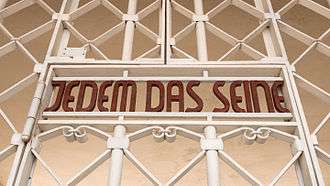Franz Ehrlich

Franz Ehrlich (28 December 1907 in Reudnitz near Leipzig - 28 November 1984 in Bernburg) was a German architect, calligrapher and graphic designer. Franz Ehrlich was a student at the Bauhaus in Dessau from 1927 to 1930.[1]
Ehrlich was a Communist and was arrested and imprisoned by the Nazi regime in 1935. He was taken to Buchenwald concentration camp where, because he was an architect, he was tasked to design the entrance gates for the camp.[2] Ehrlich subsequently became the paid main designer for the camp's construction office, designing furnishings for the commandant's house among other jobs.[3] Later a fellow prisoner claimed Ehrlich had helped the Resistance by passing construction details to them.[3]
After World War II had concluded, Ehrlich worked on reconstruction in Dresden.[3] During the 1960s he was employed as chief architect for the Leipzig Trade Fair: he designed a "Fair Tower" ("Messturm") for it, but this was never built.[4]
See also
References
- ↑ Der Architekt Franz Ehrlich: Anmerkungen zu seinem Lebensweg zwischen Bauhaustradition - Fraunhofer IRB - baufachinformation.de Archived 2012-07-18 at Archive.is
- ↑ Neil MacGregor (2016). Chapter 25: At the Buchenwald Gate. Germany: Memories of a Nation. Penguin Random House UK. pp. 467–468.
|access-date=requires|url=(help) - 1 2 3 Nicholas Fox Weber (23 December 2009). "Deadly Style: Bauhaus's Nazi Connection". The New York Times. Retrieved 26 October 2014.
- ↑ Jürgen Tietz (19 February 2008). "Tradition und Moderne ... Eine Retrospektive in Dessau erinnert derzeit an den Architekten Franz Ehrlich. Dieser schuf in der DDR ein umfangreiches Werk, in dem die Ideen des Bauhauses weiterwirkten". Neue Zürcher Zeitung. Retrieved 28 December 2016.
External links
- Franz Ehrlich. A "Bauhäusler" in the Resistance and the Concentration Camp. An exhibition of the Buchenwald and Mittelbau-Dora Memorials Foundation, 2 August to 11 October 2009 at the Neues Museum in Weimar.